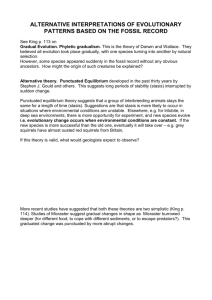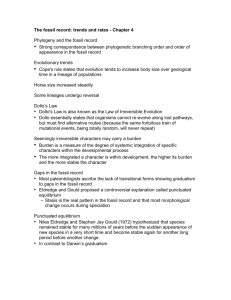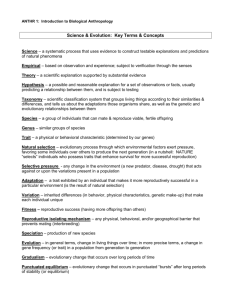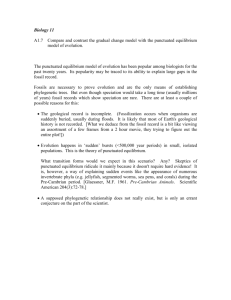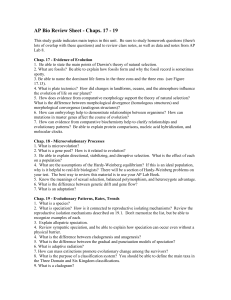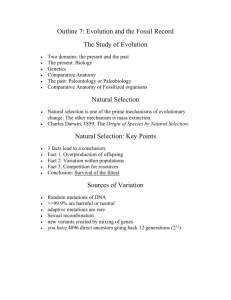Tempo and Mode of Evolution The fossil record tells us a great deal
advertisement
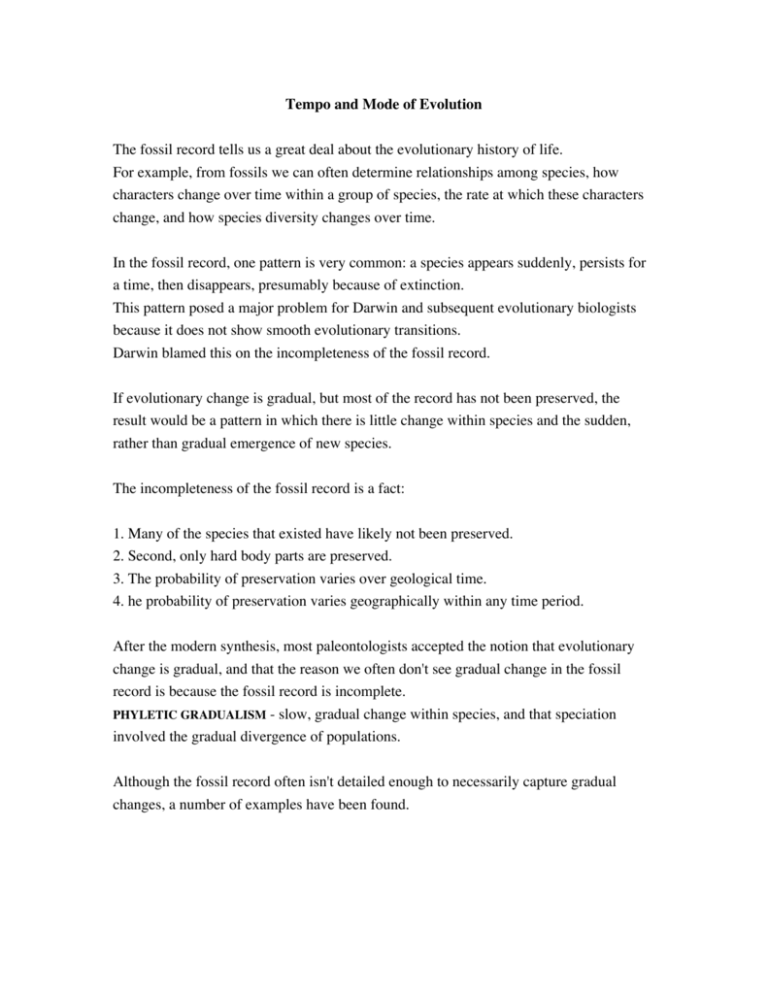
Tempo and Mode of Evolution The fossil record tells us a great deal about the evolutionary history of life. For example, from fossils we can often determine relationships among species, how characters change over time within a group of species, the rate at which these characters change, and how species diversity changes over time. In the fossil record, one pattern is very common: a species appears suddenly, persists for a time, then disappears, presumably because of extinction. This pattern posed a major problem for Darwin and subsequent evolutionary biologists because it does not show smooth evolutionary transitions. Darwin blamed this on the incompleteness of the fossil record. If evolutionary change is gradual, but most of the record has not been preserved, the result would be a pattern in which there is little change within species and the sudden, rather than gradual emergence of new species. The incompleteness of the fossil record is a fact: 1. Many of the species that existed have likely not been preserved. 2. Second, only hard body parts are preserved. 3. The probability of preservation varies over geological time. 4. he probability of preservation varies geographically within any time period. After the modern synthesis, most paleontologists accepted the notion that evolutionary change is gradual, and that the reason we often don't see gradual change in the fossil record is because the fossil record is incomplete. PHYLETIC GRADUALISM - slow, gradual change within species, and that speciation involved the gradual divergence of populations. Although the fossil record often isn't detailed enough to necessarily capture gradual changes, a number of examples have been found. In 1972 S. J. GOULD and N. ELDREDGE proposed that the pattern we see in the fossil record isn't necessarily an artifact of the fossil record being incomplete. They proposed that most species actually change little during their history, a state called stasis. In addition, they proposed that most evolutionary changes occur at speciation; not gradual change, but sudden change. They called this pattern PUNCTUATED EQUILIBRIUM. Gradualism vs. Punctuated Equilibrium Evolutionary Change Within species During speciation Phyletic Gradualism usually gradual usually gradual Punctuated Equilibrium little (stasis) rapid (punctuated) The logical basis for phyletic gradualism should be obvious. There are changes within species due to natural and sexual selection. Populations diverge and speciation occurs as different populations respond to different environments. The logical basis for punctuated equilibrium may not be as straightforward Why does most evolutionary change occur at speciation? To explain rapid evolution at speciation Gould and Eldredge drew on the PERIPHERAL ISOLATE model of speciation. This model proposes that speciation occurs in small populations separated by a barrier from other populations. Allopatric event in Peripheral Isolates A small population on the edge of a species range may experience extreme conditions And may evolve rapidly - because of drift and selection Speciation may be accompanied by a genetic revolution - an extensive reorganization of the gene pool Gould and Eldredge argued that rapid evolution is most likely to occur in small populations. Isolation eliminates the homogenizing influence of gene flow. Genetic drift and selection can thus cause rapid divergence of the small, isolated population from the original population. These small, isolated populations may diverge so much that they become different species. Mechanisms for Stasis To explain stasis two ideas have been invoked: STABILIZING SELECTION and EVOLUTIONARY CONSTRAINTS. Stabilizing selection - Under stable environmental conditions intermediate phenotypes may be selected and traits may be kept from changing over time It would seem unlikely that the environment and therefore selection would remain stable over vast periods of time However, an organism may be buffered from large environmental changes through habitat selection. Evolutionary constraints are factors intrinsic to the organisms that prevent it from responding to selection (e.g., lack of genetic variation, non-heritable traits, etc.) One approach to answering the question of stasis in the context of evolutionary constraints has been to focus on “living fossils” – species or clades that show little or no measurable morphological change over extended periods Why have these species failed to change? One possibility is that it is simple due to a lack of genetic variation Another explanation for the pattern of stasis has been put forth by Stanely and Yang (1987) - “zig-zag” evolution Little net change within a species, but a great deal of fluctuation Due to changes in response to environmental changes over time Because these changes tended to fluctuate about a mean value, the overall pattern was one of stasis This pattern has also been referred to a dynamic stasis Points to Ponder Time and Scales of Observation In the case of distinguishing stasis from gradual change in the fossil record, the finer the time scale, the better off we are Rules for Testing the Pattern Our goal is to follow changes in morphology in speciating clades through time and determine: 1) whether change occurs in conjunction with speciation events or independently and 2) whether rapid change is followed by stasis or continued change The theory of punctuated equilibrium can become tautological We define fossil species on the basis of morphology, so it might be trivial to observe a strong correlation between speciation and morphological change To avoid circularity, an acceptable test requires that 1) the phylogeny of the clade is known, so we can identify which species are ancestral and which descendant and 2) ancestral species survive long enough to co-occur with new species in the fossil record Note: If the second criterion is no fulfilled, it is difficult to know whether the new morphospecies is indeed a product of a splitting event or the result of rapid evolution in the ancestral form Q. Example of punctuated equilibruim? One group in which evolution does appear to have been punctuated is snails in Lake Turkana in Kenya in the Pliocene and Pleistocene The fossil record is extraordinarily complete for these snails, and it appears that for long periods of time snails show no change in morphology. These periods of stasis are punctuated by periods of rapid evolutionary change. These rapid evolutionary changes are usually, though not always, associated with speciation. There is thus some evidence for the punctuated equilibrium idea. Summary In reality these two models for the pattern of evolutionary change are not mutually exclusive. Instead, they represent two ends of a continuum, and patterns of evolutionary change may fall anywhere in between. For example, some species may show little evolutionary change over time while others may show substantial evolutionary change. Some speciation events may involve rapid evolutionary divergence while others may involve slow evolutionary divergence. Stasis may be associated with gradual divergence or gradual change within a species may be associated with rapid divergence at speciation. Which patterns are more common, or if all are nearly equally common, is currently unknown.
